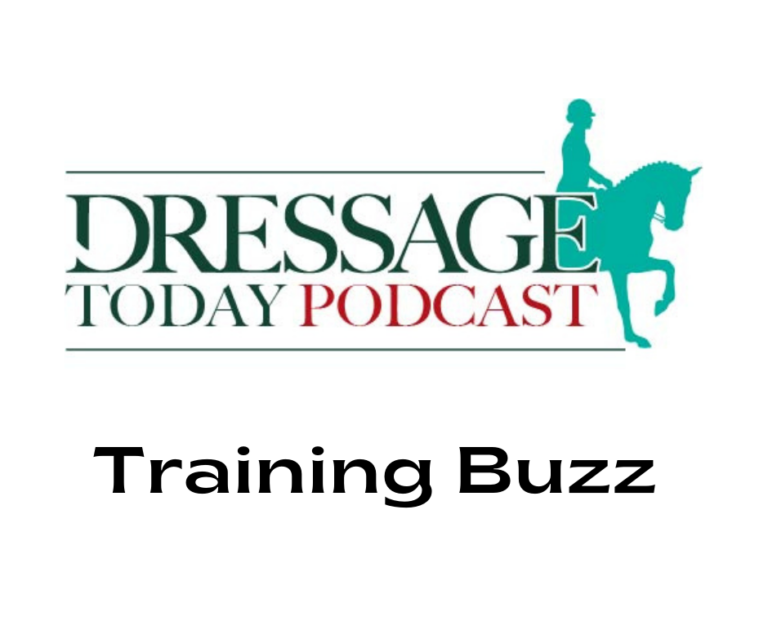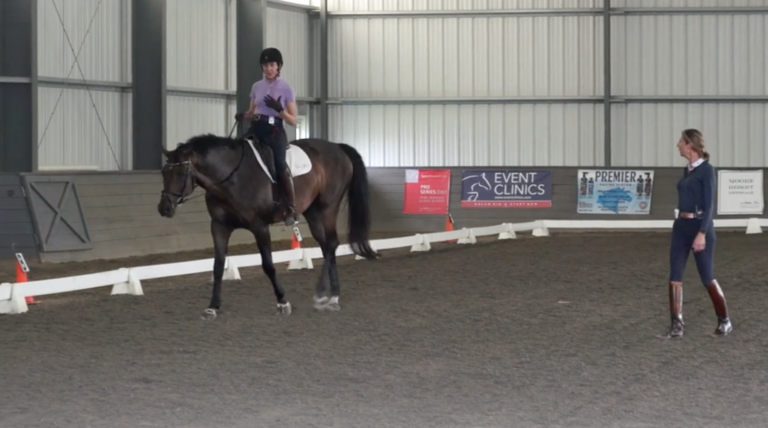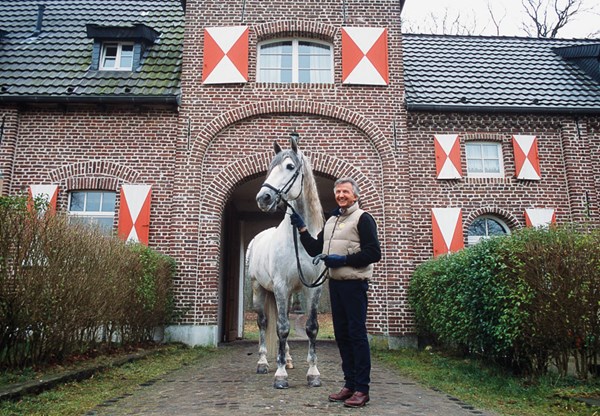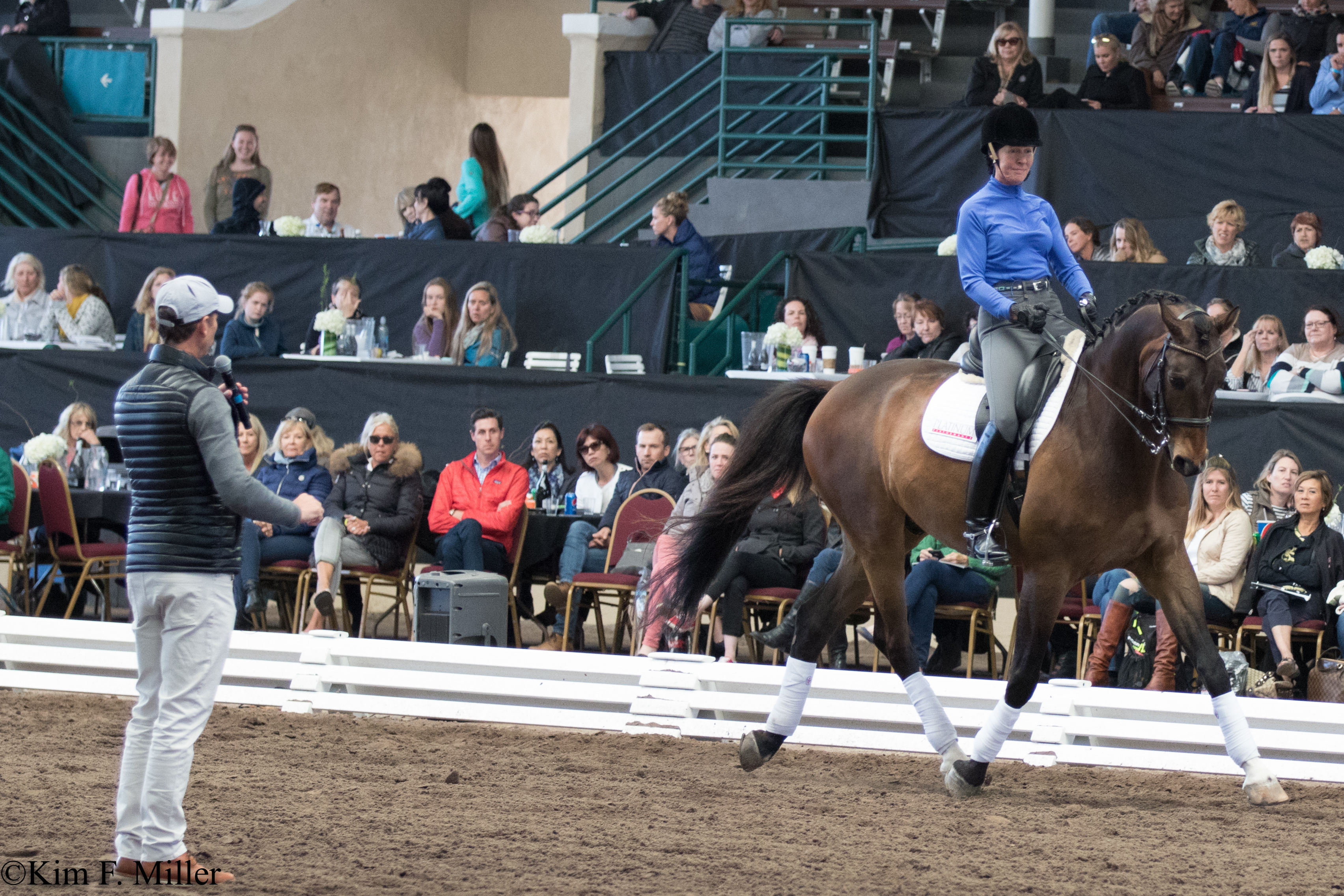
The clinic organizer described him as the Steve Jobs or Elon Musk of the dressage world, and one participant shrieked “I get to ride with God!” when she learned she was selected to ride in the Carl Hester clinic in Southern California, April 8–9, 2017. If “God” is anything like the five-time British Olympian, we’re all in good hands.
Funny, down to earth and with a penchant for the positive, Carl educated and entertained a crowd of about 1,400 in San Diego’s Del Mar Arena while coaching 13 horse-and-rider pairs over two days. All but one were professionals and they rode horses ranging from 4-year-olds to the 11-year-old Danish Warmblood Hamilton, whom Olympian Charlotte Bredahl-Baker hopes to debut soon at Grand Prix. That spectrum allowed Carl to address many common issues and broadly applicable training exercises for horses and riders. The building-block nature of dressage training was a recurring theme in Carl’s teachings. For example, a good piaffe and passage come from a good trot; a good flying change comes from a good canter; a good pirouette comes from a good shoulder-in, etc.
He applauded the riders’ willingness to work on their own and their horses’ weaknesses in such a public forum as he shared one of many personal anecdotes from his 30-year career. In this case it was recounting that on winning his first world championship, “I finally felt I had learned to ride,” he said. “I grew up riding without any of this intricate training.” One of his mentors, however, informed the then 21-year-old Carl “that he had only learned to steer.” He still had a long road ahead as does everyone who embarks on the dressage journey. He encouraged all to be open-minded to criticism, to different ways of training and to suggestions from experts and non-experts alike.
Spectators came from throughout California, the Northwest, many points east and all parts of Canada to see Carl give his first public clinic on the West Coast. It was just a week after the World Cup Final in Omaha, Nebraska, where he rode Nip Tuck to a third-place finish. He’d then snuck in a quick trip to Florida to coach Katherine Bateson-Chandler before flying west to a very appreciative audience. Toward the end of the clinic, Carl commented on the crowd’s easy-to-please nature. “At our yard, you have to do a triple pirouette to get even a clap!”
Staged as the fourth West Coast Dressage Convention by Canadian special-event producer Scott Hayes, the clinic built on smaller but well-received sessions in Vancouver with Anky van Grunsven, Adelinde Cornelissen and others, then with Carl’s protégé and now training partner Charlotte Dujardin last fall in the Los Angeles area.
Scott acknowledged that Carl’s name is a big draw and also credited the clinic’s unique format—a combination of education and a fun social event—for the big attendance. The aim, he said, was “a fun horse-girl vacation” and, indeed, many attendees (including several men) went in together on VIP tables that lined the court within the Del Mar Arena and the grandstand boxes surrounding it. Linens, champagne and elegant centerpieces graced the tables, and ringside lunch and dinner were part of the VIP package. There was ample general admission seating, too, and a vendor area hopping with familiar California companies and fresh foreign faces. These included British breeders Mount St. John, from whom Charlotte has purchased three youngsters, German footing company ReitenRight and an informational booth for Brooke USA, the domestic branch of the equine welfare endeavor for which Charlotte is a leading ambassador.
Following a short video recap of his remarkable and ongoing career on the JumboTron, Carl began by saying that “It’s not dressage that’s hard, it’s making dressage look easy that’s hard. And that’s what I’m going to try to help you with.”
Riding the Young, Hot Horse
Both days began with the youngest horses. On Saturday Amelie Kovac’s wide-eyed 4-year-old, Ivar, provided Carl the perfect entry to talk about the importance of beginning with the first levels of the German Training Scale: rhythm and relaxation. Ivar’s brilliance and expansive paces were obvious as Amelie did her best to contain his nervous energy in the highly charged environment.
With his neck tense and nose tucked in considerably behind the vertical, Ivar floated around the ring “looking at what you’re wearing, what you’re eating,” Carl told the audience. “He’s interested in everything you’re doing.”
He encouraged Amelie to use Ivar’s inquisitiveness to help him relax. By letting him edge his nose forward and out to look at something, then lifting her hands slightly and lifting her upper body, Amelie helped shape a more relaxed frame for his neck and back. “You are teaching the horse how to react to your body,” Carl explained.
The dressage mantra “forward forward” was no problem for Ivar, but forward isn’t constructive without balance, Carl cautioned. Accepting contact from leg, rein and seat aids that create that balance is lesson number one for any horse and is the hardest and most important for a high-strung young one. It’s natural for riders to hold their leg off the horse’s side to avoid urging him on, but that’s a mistake. “You want to tell the horse, ‘I hope you know I’m here,’ not ‘I hope you know I’m not here.’” Later, he noted the distinction between a “light leg” and an “empty leg.”
Small tips contributed to Ivar calming down a bit within the short session. One example was Carl asking Amelie, at the walk, to alternate between standing in her stirrups and sitting in the saddle. “What’s happening?” he asked. “You’re relaxing your bottom. You’ll see your horse will suddenly start to breathe.”
Carl adored Amelie’s hot horse and saw clear Grand Prix potential in him given the brilliance of his paces. “That hotness will come into play at the other end of his career.” Lots of relaxing and stretching work lay ahead for the pair and it would come from willing acceptance of the aids rather than any attempt to wear him down. “That won’t happen: He’s an Energizer Bunny.”
Carl advocates all horses spend as much time in pasture as possible. He acknowledged that’s harder in densely populated California than at his yard in bucolic Gloucestershire, England.
If Ivar was his horse, “he would live in a field and I would ride him 20 minutes four times a week.” He later explained that 20 minutes of work each day is typical of his and Charlotte’s routine with all horses. Usually it’s two days on, one day off, the former being a learning session, the latter strictly fitness—often a groom walking them up and down hills. “The first day they learn a lot, the second day they get their head around the lesson, and we find they learn quicker than without the day off.”
In addition to fostering looseness in body and mind, plenty of free time enables the regular movement that Carl considers the biggest factor in maintaining soundness. At his yard, morning riding sessions are followed by some form of afternoon exercise, such as hacking on the roads and up and down hills. Sundays are total off days.
Talent-Spotting
Always evaluating young horses as Grand Prix prospects, Carl said temperament and paces are at the top of his priorities. Conformation is important, but he cited the recent roster of World Cup Final contenders as proof that horses of all sizes and shapes are capable of doing dressage brilliantly on the biggest stages.
Even the most physically gifted horse, however, must have the right mind to handle the unique experience of competing internationally. The World Cup Omaha 2017 was unusual, he explained, because the warm-up area was surrounded by the public milling about and riders were also given an afternoon to familiarize their horses with the real ring. More typical is the Olympia Horse Show in London. “The warm-up is half the size [of the Del Mar arena] and it’s very peaceful and quiet, then you go through this tunnel and into an arena with 8,000 cheering people and you have 45 seconds to start your test, in which the first thing your horse has to do is stand still! Whoever designed dressage tests?
“In London [during the 2012 Olympics], because of the TV schedule, there was no time to ask for a second round around the court. You trotted in and went straight to the entrance. It’s an awful lot to ask. So it’s good to understand that performance can be affected by tension.” Temperament is also hard to predict because sometimes as horses become bigger and stronger, “they might flex their muscles and their personalities.”
Next come paces, with more concern for the walk and canter because the quality of trot can be greatly improved by training and strengthening. Ideal traits include solid, even rhythm in the walk with some overstep and a canter with plenty of push from behind.

Sunday’s first horse/rider pair, Joseph Newcomb and the 4-year-old For Finland, illustrated enticing mechanics in the canter. “Seeing how high he comes off the ground with his hind leg has me looking at the future. Mechanics like that will make for high marks, especially for flying changes.”
But don’t be a sucker for huge movements, he advised. “If you pick a walk that has so much overtrack and hugeness to it, you will often see that’s where the problems are in collection. It can be difficult for that horse to go up and down quick.” Also, “there’s a different walk for a breeding champion than for a Grand Prix horse. The Grand Prix horse’s walk is not super big.”
A horse with three terrific gaits is hard to find. Carl’s 2012 Olympic mount, the 10-year-old KWPN stallion Uthopia, for example, had “the most wonderful trot and canter, but a small walk,” he shared. “Not an incorrect walk, just a small one, without a big overtrack. We’d go from an 82 percent to a 78 percent and all we’d done was walk from here to there.”
A calm demeanor and relaxed frame were additional positives Carl noted about For Finland. At the end of their session, the gelding dropped his head low and began to “look for the bit,” showing that he’d already given himself to the rider, Carl explained. He then contrasted that with the previous day’s 4-year-old, Ivar, who had fabulous gaits and a fiery presence but with his temperament, he was not ready to let go yet. Neither horse was better or worse than the other—they were just different and would require different training techniques.
Carl emphasized that patience is paramount. “Now all you have to do is wait five years,” he told Joseph. “Even presuming that a 4-year-old is ridden well for one year, bear in mind that there will be growth spurts and changes. We actually think it’s good to give the horse a holiday during that time. They are often better when they come back than if you had schooled them for those five or six weeks.”
Progress rarely happens in a straight line, with Valegro being “the tragic exception,” Carl said. The retired rock star “did his whoop-de-doos all the way to the top, which is then horrendous for the other horses in the yard. That’s why he has such a smug look on his face.”
Conversely, Carl’s 2004 Olympic partner, Escapado, was 8 before he could do a flying change, “because all he ever did was the flying part. But when he learned it, he never made a mistake.” For a long time, the prospect of changes made him so nervous he shrank his canter “to the size of a peanut,” hence his nickname “Peanut.”
During the clinic, Carl helped Cyndi Jackson’s Sir Amour prepare for 6-year-old competition, which adds the flying change. First, Carl wanted to add more suspension and upward jump to his canter to improve that gait and prepare for the changes. On a 20-meter circle, Cyndi was asked “How short can you get your canter? You’ll have to use the contents of those boots!” Using half halts, light taps of the whip and give and take with the reins, she was asked to “bring him more on the spot without hanging on” to work toward him sitting behind while maintaining forward impulsion. Even when a downward transition went poorly, Carl insisted Cyndi finish it to reinforce the critical forward aspect. To interrupt it by coming down to the walk reinforces the opposite. Reiterating the need for patience, Carl said, “You’ll get him on his hind leg within a few years, not a few minutes.”
Body Position
An independent seat derived from core strength is a trait that separates great riders from the rest. Carl’s favorite exercise is learning to feel your balance by riding without stirrups. “Everybody thinks of that as a punishment so they never do it,” he said. That’s also “because it’s really uncomfortable” and, in some cases, can hurt the horse’s back. If either are the case, or for beginners, start with the canter because it is easier to sit.
Carl told several riders to pull their belly button in and think of “a magnet on hat and roof” to help them lift their upper body posture and, in turn, their horse’s frame. “Very few riders are in self-carriage themselves, and if you’re not, your horse certainly won’t be.” Upper-body strength leads to better body alignment. In creating a more effective position, it also improves the presentation. “You’ve got to ride like you are dressed to go out. Have that showmanship!”
Along with horses learning what each rider’s aid means, riders must understand the influence of each aspect of their position. “Watch jumper riders and you see they take a position over the knee and their horse is through and soft in the back. Then you see a dressage rider’s upright and strong position and the horse is bracing in the back.” While Carl didn’t suggest a two-point position, he did encourage riders to experiment with different body positions and be very attuned to the effect those changes had on their horses. He had several riders experiment with posting in the extended trot to see whether the horse’s back loosened and the stride opened more when they came out of the saddle instead of sitting. In most cases, the result was loosening of the horse’s back and opening of the stride. “It’s not a sin to rise in your lateral work. I like the rising trot to help a horse stay in rhythm,” he added.

Carl’s constructive tips for the young-horse riders fit perfectly with a Saturday lunch demonstration organized by USEF Young Horse Coach Christine Traurig. The demo included three young horses working in the arena and discussion from Christine and Carl about young-horse development, the Young Horse Program and the role training young horses plays in a professional’s development.
“We are looking to cultivate and educate our youth and not just the two-legged ones. It’s very important, especially here in the U.S., because the skill of riding young horses is the skill of training.” Carl seconded that. “Ideally everyone starting out gets their experience with an older horse. But to become a horse person, a real rider, you have to start training your own.”
The advice wasn’t limited to young riders or young horses. Amateur Nan Meek went home excited to apply exercises given to David Blake’s spectacularly high-stepping 7-year-old to her 25-year-old schoolmaster. The long-side exercise of alternating half-pass and shoulder-in was suggested to help prepare David’s Oldenberg mare, Heide Spirit, for pirouette, but Nan felt it would also help her veteran improve all his gaits and movements by getting his hind leg properly underneath him, creating more push and building hindquarter strength.
“I love that Carl puts different movements into an exercise that helps you solve a problem. We all have similar problems with rhythm, submission, activity of the hind end, etc. He’s addressing the fundamentals of training and not papering over any of the cracks.”

Sarah Tubman was the rider who exclaimed about “riding with God” on receiving her clinic invite. Her excitement was not just because of Carl’s fame, but for his ability to bring along so many young horses. Sarah’s session was with her own young horse, Dehavilland, a 6-year-old she’s brought along since the age of 3. She said her session was “awesome,” but not because Carl imparted any God-like miracles. “I think we were all waiting with baited breath to see if he had some magic potion for making it all work,” Sarah reflected. “Instead, it was great for everybody, including my clients, to see that he has made so many top horses and riders from the basics. He definitely has his own way, but he always held true to the fact that it’s all about the basics and the foundation. Unfortunately, there are no quick fixes.”
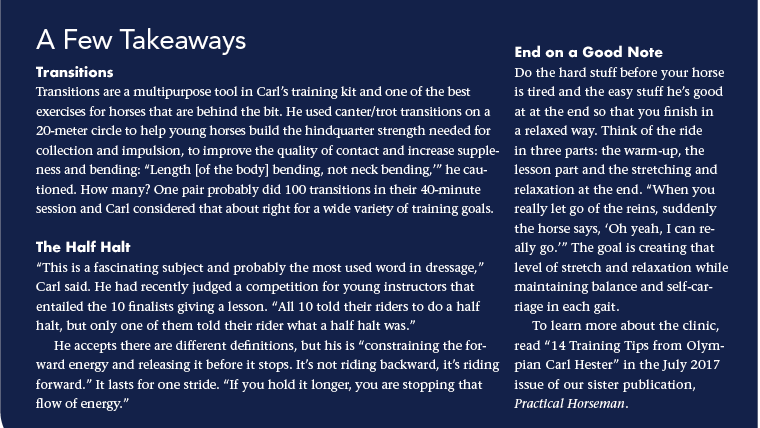
This article first appeared in the July 2017 issue of Dressage Today magazine.



